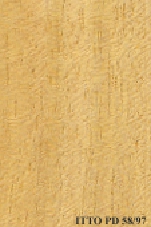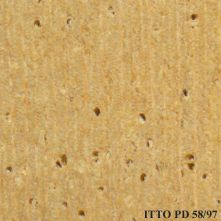
KAPOKIER (Bombax costatum)
Trade Name
Kapokier
Scientific Name
Bombax costatum Vuill.
Family
BOMBACACEAE
Common Names
Kapokier (Senegal); Kapokier (Côte d`Ivoire); Bumbum (Burkina Faso); West African Bombax (United Kingdom); Ougoumalanga (Gabon); Esodoum (Cameroon); Kapokier
Scientific Name Synonyms
Bombax vuilleti Pellegr.; Bombax houardii Pellegr. & Vuillet
Description Of The Tree
Botanical Description
The tree reaches a height of 26 to 40 m, with diameters from 130 up to 200 cm. The boles are straight and cylindrical, sometimes buttressed.
Natural Habitat
Bombax costatum is found in savanna and secondary forests as well as dense rain forests.
Natural Distribution
West Africa and extending eastward into Tanzania.
Wood Identification
Anatomic Description Of Wood
Wood diffuse porous. Occasionally vessels exclusively solitary (over 90%). Tangential diameter of vessel lumina 200 micras or more (large). Tyloses thin walled. Non-vestured pits. Vessels per mm2 less than 6 (rare). Simple perforation plates. Vessel-ray pits sim Apotracheal axial parenchyma diffuse and/or diffuse in aggregates. Axial parenchyma storied. Prismatic crystals in non-chambered axial parenchyma cells. 3 to 4 cells per parenchyma strand. 4 to 10 rays per mm (medium). Rays non-storied. Larger rays more than 4 seriate. Occasionally prismatic crystals in the ray cells. Heterogeneous rays and/or multiseriate heterogeneous rays. Non-septate fibers. Fibers with simple to minutely bordered pits.
-
 Wood Macro Photo Radial Plane
Wood Macro Photo Radial Plane
-
 Wood Micro Photo Of Transversal Section
Wood Micro Photo Of Transversal Section
Availability
Cites Status
Unrestricted
General Wood Description
Color
The heartwood is whitish to pinkish grey, it is not demarcated. The silver figure is medium to large.
COLOR INDEX (1=Black, 7=Light yellow,white)
7
Grain
Straight; grain has no particular influence on drying, machining and finishing qualities.
Texture
This species is usually reported to have a coarse texture.
Luster
Luster is generally moderate to high.
Natural Durability
Not durable; important risks of decay attacks at any processing step, from logs up to final products. It must receive preservative treatment. Sensible to termites attack. Heartwood is sensible to Lyctus attacks.
Natural durability index (1= Very high durability, 7=Vey low durability)
5
Internal Growth Stresses
For this species no growth stresses are reported.
Silica Content
Silica Content: This timber is reported to have a negligible silica content. Silica contents over 0.05% may affect wood processing. Silica Value: 0.02
Resistance To Impregnation
Easy to treat with a full penetration of the preservative products using vacuum-pressure method.
Wood Physical Properties
Basic Density or Specific Gravity (O.D. weight/vol. green) (g/cm³)
0.39
Air-dry Density (Weight and volume at 12%MC) (g/cm³)
0.41
Total shrinkage Tangential (Saturated to 0%MC) (%)
5.4
Total shrinkage Radial (Saturated to 0%MC) (%)
3.1
Drying Defects
Ease of Drying: Drying is rather slow and sometimes difficult to perform. Drying Defects: Risks of casehardening and checks Kiln Schedules: The kiln schedule has been tested.
Recommended Dry Kiln Schedule
FR-2
Dimensional stability ratio (Total Tangential Shrinkage %/Total Radial Shrinkage %)
1.8
Wood Chemical Properties
Wood Mechanical Properties
Bending Strength (MOR),12%MC (kgf/cm²)
466
Stiffness (MOE) 12%MC (kgf/cm²)
61794
Compression parallel to fiber 12%MC (kgf/cm²)
277
Compression perpendicular to fiber 12%MC (kgf/cm²)
28
Shear strength radial 12%MC (kgf/cm²)
41
Janka hardness (side) 12%MC (kgf)
207
Janka hardness (end grain) 12%MC (kgf)
299
Workability
Sawing
It is easy to saw.
Rotary Veneer Cutting
Suitable for peeling without treatment.
Sliced Veneer
Suitable for peeling without treatment.
Blunting Effect
Slight blunting effect; ordinary tools can be used for sawing and machining.
Machining
Machining of this species is reportedly easy.
Planing
Easy; no particular problems.
Moulding
Rather difficult; special tools are needed.
Boring
Rather difficult; special tools are needed.
Mortising
Rather difficult; special tools are needed.
Nailing
Easy to perform but low nails holding.
Gluing
Glues well if basic gluing technical rules are followed.
Sanding
Particular care is needed to avoid woolly aspect of the surface.
Polishing
Needs pre-coating.
Response To Hand Tools
No particular problems.
REFERENCED USES
End Uses Summary
FURNITURE AND CABINETS, common furniture, PLYWOOD AND VENEER, cores, PACKING, light packing, OTHER AND MUSICAL INSTRUMENTS, door core, moldings, scale model
Furniture Cabinets
- 21 - Tropical timbers of the world. Part III-Southeast Asian and Oceanian Species.
Furniture, Common
- 23 - Handbook of Hardwoods
Panels, Veneers
- 25 - Directory of Timber Trade Malaysia
Cores
- 27 - Embassy of Brazil in Japan
Packing
- 45 - Recopilación y Análisis de Estudios Tecnológicos de Maderas Peruanas
Light Packing
- 46 - ECUADOR, Inventario y Aprovechamiento de los Bosques del Sur Ecuatoriano
Door Cores
- 76 - Descripción General y Anatómica de 105 Maderas del Grupo Andino.
Molding
- 79 - Padronização da Nomenclatura Comercial Brasileira das Madeiras Tropicais Amazônicas, Sugestão
Scale Models
- 83 - Algunas caracteristicas fisicomecanicas de la madera de tres especies de la cordillera NeoVolcanica
Please Provide Information To View Producer Information